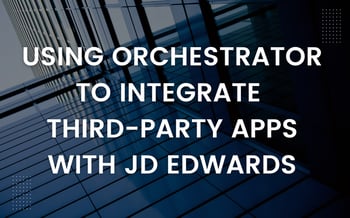Using Orchestrator to Integrate Third-Party Apps With JD Edwards
How to Use Orchestrator to Integrate Third-Party Apps with JD Edwards
 Businesses are incorporating automation at an incredible rate: The global business system automation market is expected to jump 12.2% year-over-year between now and 2026. JD Edwards Orchestrator is a powerful tool that can help automate business processes and increase efficiency, especially when using third-party applications. Here are some tips for using JD Edwards Orchestrator to integrate third-party applications in your tech stack seamlessly.
Businesses are incorporating automation at an incredible rate: The global business system automation market is expected to jump 12.2% year-over-year between now and 2026. JD Edwards Orchestrator is a powerful tool that can help automate business processes and increase efficiency, especially when using third-party applications. Here are some tips for using JD Edwards Orchestrator to integrate third-party applications in your tech stack seamlessly.
Tip 1: Get Familiar With the Basics of JD Edwards EnterpriseOne Orchestrator
You can use Orchestrator to automate workflows such as purchase order approval, invoice processing, and freight and logistics, but it's best to start by getting familiar with the basics.
Orchestrator is a Representational State Transfer (REST)-based integration platform that supports various integrations with cloud services, third-party applications, custom programs, and more. It's designed to make it easy for developers to create and manage integrations between different systems. Additionally, Orchestrator provides several features - like logging and auditing - that make managing and monitoring integrations easier.
JD Edwards Orchestrator uses REST to provide an interface for external applications to access and interact with the JD Edwards EnterpriseOne AIS Server. REST is a web service architecture that allows applications to communicate with each other over the internet. With REST, applications can send and receive data in a standardized format, such as JSON or XML.
You can also access services such as Application Stack Service, Batch Form Service, and Business Function Service by sending a REST request to the AIS Server. And with REST, you can use JD Edwards Orchestrator to create connections to external services, such as Yahoo Weather.
Tip 2: Consider Data Types While Making Connections
Once you understand the basics of Orchestrator, the next step is to create a connection to the third-party application. You can do this by using the REST adapter in Oracle Integration and providing the following:
- A meaningful name and identifier
- The URL of the third-party application
- Any authentication information that may be required.
Once you've established the connection, you can create the integration.
However, it's essential to consider the data type exchanged between the two systems when creating the integration. For example, if you are integrating with a customer relationship management (CRM) system, you may need to exchange customer data between the two systems. Additionally, you may need to consider the data format. Let's say you're exchanging customer data. In that case, you may need to convert the data from one format to another.
Tip 3: Leverage the Power of Conditions
You can use conditions to control the orchestration flow based on the data's state. This approach can help automate complex business processes and make them more efficient when integrating with third-party applications.
For example, you can define conditions like the data that needs to be sent, the data type, and the sending frequency. These conditions can be beneficial when integrating with an external application.
Suppose you're using Orchestrator to integrate with an inventory management app. You can set up conditions to pull inventory data once daily at 2:00 pm. This way, you have enough time to place any necessary orders before closing up shop at 5:00.
Tip 4: Test, Test, Test
Testing a third-party integration in JD Edwards is vital to ensure a successful integration because it lets organizations identify any potential issues before they become significant problems. This helps ensure:
- The integration is working as expected
- Any data exchanged is accurate and secure
- Minimal security risks and vulnerabilities that malicious actors could exploit
Data security is paramount when integrating with third-party applications because you don't want your team—or that of another company—to run afoul of GDPR, Sarbanes Oxley, HIPAA, or any other data protection standards.
Leverage Encryption While Testing
When integrating with third-party applications, you must ensure that the data is secure and that the integration is not vulnerable to attack. To do this, you should use secure protocols such as Transport Layer Security (TLS) and Secure Socket Layer (SSL), as well as encryption and authentication techniques. Additionally, you should consider using a secure gateway to protect the integration from external threats.
Testing the integration also allows organizations to identify any potential performance issues that could arise during the integration process. It can help ensure the integration runs as efficiently as possible and that any data exchanged is processed promptly.
Additionally, testing the integration can help identify potential scalability issues that could arise as you add other third-party app integrations over time.
Master JD Edwards Orchestrator With GSI
By following these tips, you can use JD Edwards Orchestrator more effectively and efficiently while automating business processes to increase productivity and improve business outcomes. With GSI's seasoned JD Edwards pros at your side, you can get up and running faster and dive deeper into its many features and uses. Reach out to GSI today to see how GSI can help with your JDE implementation.
